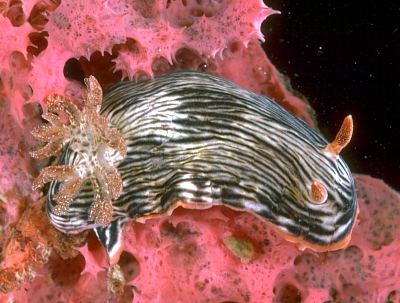
Chromodoris striatella
Bergh, 1876
Order: NUDIBRANCHIA
Suborder: DORIDINA
Family: Chromodorididae
DISTRIBUTION
Tropical Indo-West Pacific.
PHOTO
Mandorah Jetty, Darwin, Northern Territory, Australia, on wharf pile on 'darwinellid sponge', 6 m. 45, 58, 58 mm long alive. 26 June 1987. AM C153612 Upper - on food sponge. Lower - two adults showing colour variation. Photos: Bill Rudman.
Grows to about 30mm long. It can be best described as being white with thin black lines as distinct from Chromodoris lineolata which is black with white lines. The difference is particularly clear in paler specimens in which the background colour is clearly a translucent white or straw colour. Unlike C. lineolata, this species has a white line along the inner edge of the orange border, rather then black.
See separate page for messages concerning what I consider to be a spotted form of C. striatella. It is probable that the recently described Chromodoris mandapamensis is a dark example of this same colour form.
-
Rudman, W.B. (1982) The Chromodorididae (Opisthobranchia: Mollusca) of the Indo-West Pacific: Chromodoris quadricolor, C. lineolata and Hypselodoris nigrolineata colour groups. Zoological Journal of the Linnean Society, 76: 183-241.
-
Rudman, W.B., Darvell, B.W. (1990) Opisthobranch Molluscs of Hong Kong: Part 1. Nudibranch Families; Goniodorididae, Onchidorididae, Triophidae, Gymnodorididae, Chromodorididae (Nudibranchia). Asian Marine Biology, 7: 31-79.
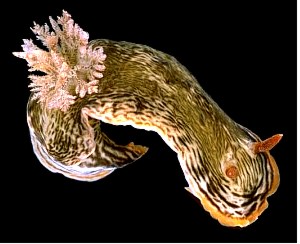
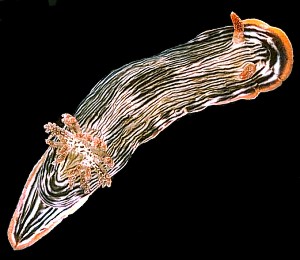
Rudman, W.B., 1999 (June 19) Chromodoris striatella Bergh, 1876. [In] Sea Slug Forum. Australian Museum, Sydney. Available from http://www.seaslugforum.net/find/chrstria
Related messages
Re: Another Chromodoris striatella? from Indonesia
July 25, 2008
From: Jean-François Hervé
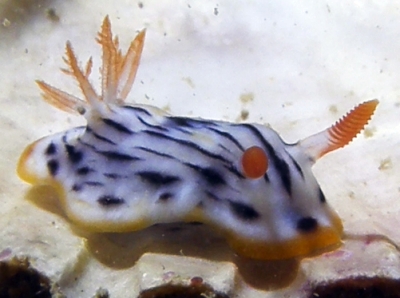
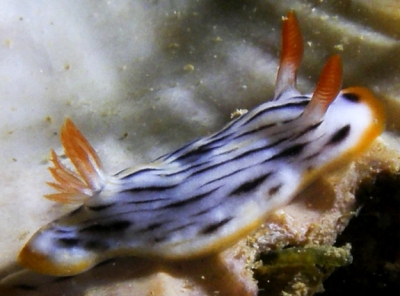
Concerning message #19347:
Dear Bill,
I just received these two photos and I wonder whether they could not help us to differentiate Chromodoris burni and Chromodoris striatella?
It seems to be a Hypselodoris maritima without the blue margin. Perhaps it's the real C. burni? I'm lost.
Locality: Noumea, 10 m, New Caledonia, Pacific ocean, 14 july 2008, muddy. Length: 2 cm. Photographer: Yves Gillet.
Thank you for your help.
Jean-François Hervé
jfherve@free.fr
Hervé, J-F., 2008 (Jul 25) Re: Another Chromodoris striatella? from Indonesia. [Message in] Sea Slug Forum. Australian Museum, Sydney. Available from http://www.seaslugforum.net/find/21702
Dear Jean-François,
In this line of study, being 'lost' can be both frustrating and exciting, because it means there are still interesting things to discover. And knowing you are lost is much better than thinking you know it all! We still have a lot of work to do on these black-lined chromodorids, and every time I see a new 'colour variant' like this I suspect we need to do quite a bit more collecting and surveying before we can sort them all out.
Your message sent me back to look at Chris Cowley's earlier messages [#19347, #19348] and your earlier message [#19123] of animals I identified as C. striatella, and Gary Cobb's message [#11159] of an animal I considered to be C. burni. I also had another look at a species Risbec (1928) described from New Caledonia as Chromodoris clavata. I have included a painting published by Risbec (1928: Plate 7, fig.2) alongside. When I published on this group of chromodorids (Rudman, 1982), I considered on anatomical and colour pattern grounds that C. clavata was a synonym of C. striatella. Risbec described the rhinophores as red and the gills as edged in red. There is no doubt that the animals in your earlier message [#19123] are the same as Risbec's C. clavata. Which I guess raises the question of whether C. clavata and C. striatella are the same species or not?
Externally, multiple black lines on the mantle, reddish gills and rhinophores with white spots, and a pattern of 5 blackish smudges on the back have all characterised C. striatella. I won't confuse the discussion by including C. lineolata, other than to say that in that species we can describe the colour pattern as white lines on a black background. Returning to C. striatella and C. clavata, the major external difference was the broad space near the mantle edge in C. clavata which lacked black lines. While not clear from Risbec's descriptions, another difference is that in C. clavata the gills and rhinophores lack the white spots of C. striatella, and the gills have black lines edging the basal part of the gills and orange edging further up. This can be seen very clearly in your earlier message [#19123].
My first thoughts were that C. clavata and C. striatella are indeed different species, as colour differences like this are not usually found in the same species in the chromodorids, but then I noticed in the middle photo of your message #19123 that the tips of the gills in the lower animal are starting to branch and are becoming translucent orange. Also if you look at Chris Cowley's two animals from Indonesia [#19347, #19348] the one in message #19347 seems to be developing gills like a typical C. striatella as in message #19348. And in Brian Darvell's Hong Kong photos [#6065] a typical C. striatella has traces of a black line on its spotted gills.
Which brings me to your animal. I think it is a juvenile of 'C. clavata'. I know the 5 black patches aren't present, but I presume they develop as the animal grows in size. The orange-edged gills are interesting because they have indications that they are developing branches near the tips, which is what you find in typical C. striatella. It seems that C. clavata is a colour form or perhaps a growth stage in C. striatella in which the gills and rhinophores have yet to develop their white spots.
Which brings me to Chromodoris burni. When I described that species I considered the black and orange lines on the gills, and the absence of 5 black patches to be of importance, but if what I say above proves correct then I am afraid C. burni is most probably a synonym of C. striatella as well. Gary Cobb's message [#11159] shows an animal which could be considered halfway between typical C. burni and C. clavata because it has a band around the mantle edge lacking fine black lines.
I hope this all makes sense. Basically I think your photo has given me a clue to the relationsips of these various colour forms. It looks to me as though the unspotted gills and rhinophores represent a juvenile or growth stage in the dvelopment of C. striatella, and if so, C. clavata should remain a synonym of that species and C. burni may have to become one.
Best wishes,
Bill Rudman
Another Chromodoris striatella? from Indonesia
June 15, 2007
From: Chris Crowley
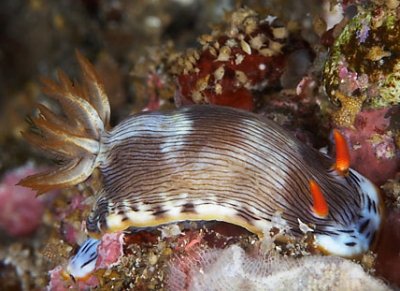
Dear Bill
Looking for help with ID.
May be a type of Hypselodoris???
Locality: Beangabang, Pantar Island, 22 meters, Indonesia, Pacific, 2 December 2006, sand and coral substrate. Length: 5 cm. Photographer: Chris Crowley.
Chris Crowley
chris.crowley@hughes.net
Crowley, C.J., 2007 (Jun 15) Another Chromodoris striatella? from Indonesia. [Message in] Sea Slug Forum. Australian Museum, Sydney. Available from http://www.seaslugforum.net/find/19347Dear Chris,
Its worth comparing this with your other photo [#19348] and Jean-Francois Herve's animal [message #19123] which I identified as C. striatella. I am beginning to wonder whether animals like yours and Jean-Francois' are really C. burni, a species which was differentiated externally on the orange rhinophores, and gills with a triangular cross-section with orange outer edges and an inner black line. If so, perhaps C. burni is just a juvenile of C. striatella because there seem to be animals in which the triangular gills merge into the more rounded C. striatella form and begin to have secondary branches.
It is certainly worth thinking about.
Best wishes,
Bill Rudman
Chromodoris striatella from Flores Is., Indonesia
June 15, 2007
From: Chris Crowley
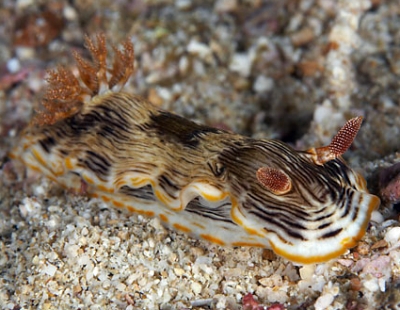
Dear Bill,
I am also looking for help with ID. May be a type of Hypselodori s?
Locality: Adanara, Flores Island, 15 meters, Indonesia, Pacific, 26 November 2006, sandy bottom. Length: 5 cm. Photographer: Chris Crowley.
Chris Crowley.
chris.crowley@hughes.net
Crowley, C.J., 2007 (Jun 15) Chromodoris striatella from Flores Is., Indonesia. [Message in] Sea Slug Forum. Australian Museum, Sydney. Available from http://www.seaslugforum.net/find/19348Dear Chris,
It certainly looks like some species of Hypselodoris, but it is a species of the related genus, Chromodoris - C. striatella -in fact.
Best wishes,
Bill Rudman
Egg ribbon of Chromodoris striatella
January 29, 2007
From: Bill Rudman
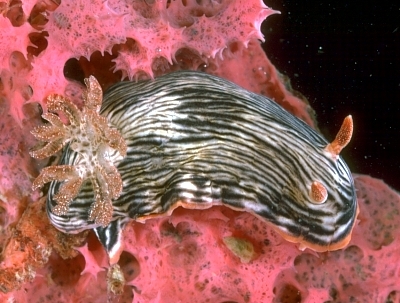
I note I have not actually recorded my observations on the egg ribbon of Chromodoris striatella, mainly because I have no photos of the eggs ribbons to include. Here are two records of C. striatella laying flat egg ribbons as described elsewhere on the Forum. The accompanying photo is of an animal from Darwin, which produced one of the ribbons.
-
1. Mandorah Jetty, Darwin, Northern Territory, Australia, on wharf pile on 'darwinellid sponge', 6 m. 45, 58, 58 mm long alive. 26 June 1987. AM C153612 Flattened transparent egg mass - on timber alongside sponge. Photo: Bill Rudman.
-
2. Angourie, northern New South Wales, New South Wales, in pool on rock platform. 5 November, 1987. Four animals - 21, 27, 30, 31 mm long alive. AM C154586. Laid flat egg mass in dish after collection.
Best wishes
Bill Rudman
Chromodoris striatella egg-laying
January 8, 2007
From: Jean-François Hervé
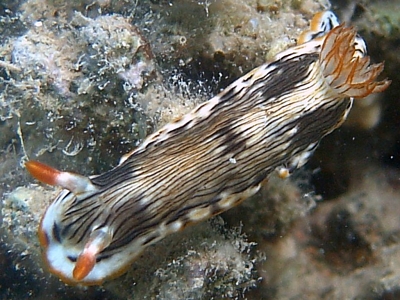
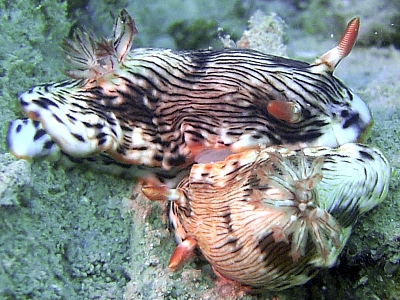
Dear Bill,
Attached is a pictures of a nudibranch a friend observed during last month in Noumea. First, I thought it's Chromodoris striatella but I'm not sure. Here are pics of mating and laying behavior.
Locality: Noumea, 6 m, New Caledonia, Pacific Ocean, December 2006, Sand, algae. Length: 30 mm. Photographer: Yves Gillet.
With Kind regards
Happy New Year
Jean-François
jfherve@free.fr
Hervé, J.F., 2007 (Jan 8) Chromodoris striatella egg-laying. [Message in] Sea Slug Forum. Australian Museum, Sydney. Available from http://www.seaslugforum.net/find/19123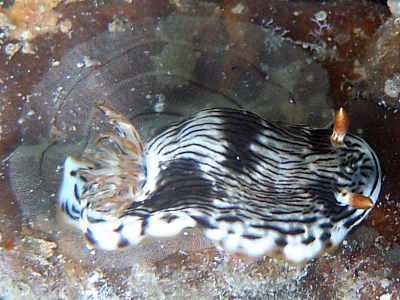
Dear Jean-François,
Yes this is a colour form of C. striatella. I have observed this species laying a flat egg ribbon in northern New South Wales so it very nice to get a photo to confirm this behaviour.
Best wishes,
Bill Rudman
Chromodoris striatella from sthn Queensland
September 30, 2003
From: Gary Cobb
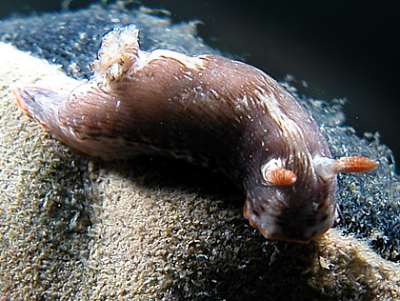
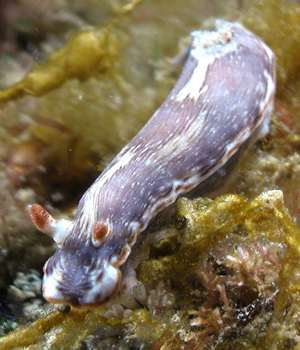
Hi Bill,
I am having trouble IDing this nuidbranch.
Location: Off Mooloolaba, Sunshine Coast, Queensland, Australia
Site: Old Woman Island - The Wall
Depth: 9m
Length: 15mm
Date: September 2003
Day time
Many thanks again,
Gary Cobb
gary@cobb.com.au
Cobb, G., 2003 (Sep 30) Chromodoris striatella from sthn Queensland. [Message in] Sea Slug Forum. Australian Museum, Sydney. Available from http://www.seaslugforum.net/find/11062Dear Gary,
This is one of the colour forms of Chromodoris striatella. This form in which the lines are very blurred is not uncommon on the east coast of Australia. I would be intersted to know what the one in the upper photo is crawling on. Is it a sponge? or is it a diver's glove?
Best wishes
Bill Rudman
Chromodoris striatella with some spots
May 14, 2003
From: Roberto Sozzani
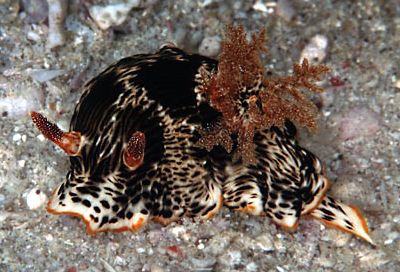
Dear Bill,
I have followed your Forum for a long time It is of great help for me. Now I need some more help, I've a lot of subjects I can't identify.
I start with this one, shot in Pandar Island (near Rinja Is. - Komodo Ids, Indonesia) on Feb. 2003. It was at about 12 meters. His size about 6 or 7cm.
Thanks in advance for your help.
Roberto Sozzani
roberto.sozzani@fastwebnet.it
Sozzani, R., 2003 (May 14) Chromodoris striatella with some spots. [Message in] Sea Slug Forum. Australian Museum, Sydney. Available from http://www.seaslugforum.net/find/9861Dear Robert,
I am glad the Forum is of value to you. This is an interesting find, especially as I am posting a message today about Chromodoris mandapamensis. Your animal is a form of Chromodoris striatella in which some of the black lines have broken into a line of spots. I would consider this to be an intermediate between the lined C. striatella and the spotted Chromodoris mandapamensis. I have seen animals like this in New Caledonia, but unfortunately my photos failed so it is good to get your photographic evidence. I have been placing 'spotted' animals on a spotted Chromodoris striatella Page, but I think I will treat your animal as a lined form with some spots.
Best wishes,
Bill Rudman
Chromodoris striatella from the Philippines
April 3, 2003
From: Erwin Koehler
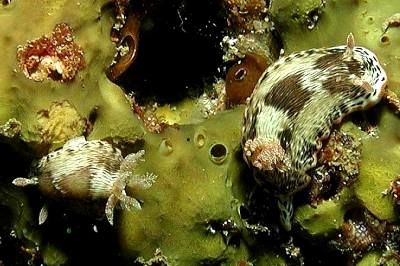
Dear Bill,
Here are 3 pictures of what I think is Chromodoris striatella from the Philippine Ids.
Data:
Malapascua Island, divesite "Gato Cave".
Length: 28mm, 36 mm
Date: 22.02.2003
Depth: 17 m
Erwin
Erwin@medslugs.de
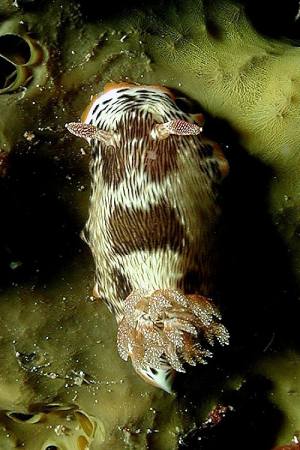
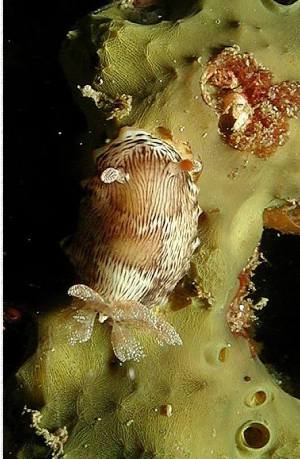
Thanks Erwin,
This is indeed C. striatella. The pattern of dark patches is present in most olour variations. Thanks also for another feeding record. Although there is no sign of the foregut protruding out, in both photos with the smaller animal, there are clear feeding scars. I have posted close-ups showing this in a separate message.
Best wishes,
Bill Rudman
Chromodoris striatella - feeding
April 3, 2003
From: Bill Rudman
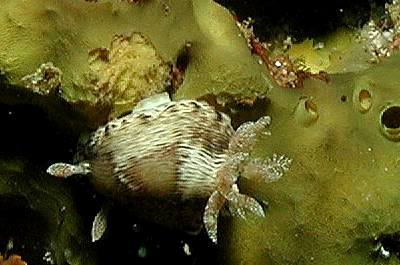
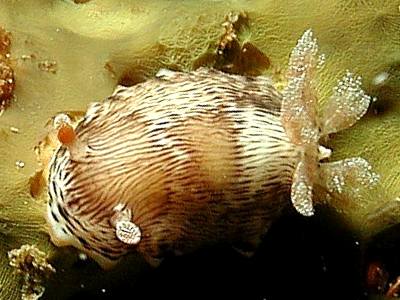
To accompany Erwin's message concerning Chromodoris striatella, here are close-ups of two of his photos to show feeding scars on the sponge colony, which I am sure indicate that this animal is feeding on this sponge.
In the upper photo there is a patch right above the animal, in which the sponge layer has been removed. I would assume from the salloped edge that this has been caused by rasping of the radula. In the lower photo the same patch is mostly obscured by the animal but some of it is visible below the right rhinophore.
Data: Philippines, Malapascua Island, divesite "Gato Cave". Size: 28mm. 22 February 2003. Depth: 17 m. Photos: Erwin Koehler.
Best wishes,
Bill Rudman.
Chromodoris striatella from SE Australia
January 27, 2003
From: David & Leanne Atkinson
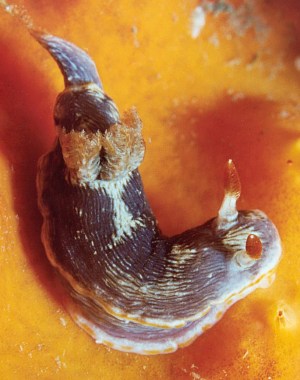
Hi Bill,
Long time no see. Leanne and I found an interesting one at Halifax Park last week. Couldn't see it in any books. We have seen it only once before. Photo attached. Any idea what it is?
David & Leanne Atkinson
atk@hunterlink.net.au
Atkinson, D. & Atkinson, L., 2003 (Jan 27) Chromodoris striatella from SE Australia. [Message in] Sea Slug Forum. Australian Museum, Sydney. Available from http://www.seaslugforum.net/find/8995Dear David & Leanne,
Glad to hear from you again. This is the same colour form of Chromodoris striatella as the photo you sent some time ago, although in this photo you can see the thin black lines more clearly in the grey areas. I have only seen this colour form in eastrn Australia at present. If you see it laying eggs, by chance, I would love a photo.
Best wishes,
Bill
Chromodoris striatella from Hong Kong
January 26, 2002
From: Bill Rudman & Brian Darvell
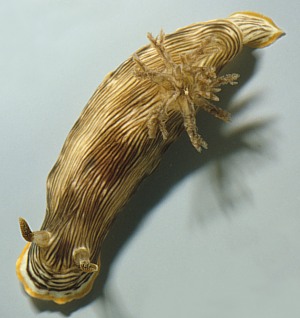
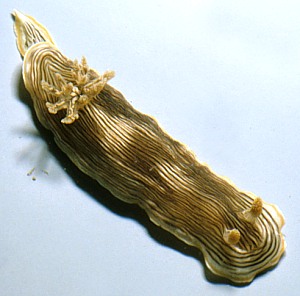
Here is some information and photos on Chromodoris striatella from Brian Darvell's Hong Kong collections.
This species is very similar in colour to Chromodoris lineolata and has often been misidentified as that species. Whereas C. lineolata can be described as black with white lines, C. striatella can be described as white with thin black lines, the background colour in C. striatella being a translucent, not pigmented, white. Usually the orange or reddish border has a band of translucent white along its inside edge. The gills and rhinophores are similar in colour to those of C. lineolata. It can grow to 50 mm in length.
PHOTO:
Upper: AM C153713, 28 June 1987, Site 8.111, Tai Long Wan, E of Is., 4 m. Depth range: 4-11 m, Hong Kong. Lower: AM C150269, 13 April 1986, Site 2.32, Round Is. (E), Mirs Bay, I 1 m, Hong Kong. Photos: Brian Darvell.
Hong Kong Collection Records:
AM C137061, 2 specimens, 14 November 1982, Site 2.32, Round Is. (E), Mirs Bay, 10 m. AM C150269, 13 April 1986, Site 2.32, Round Is. (E), Mirs Bay, I 1 m. AM C150270, 15 April 1986, Site 3.80, Ping Chau (S), Mirs Bay, 6 m. AM C153713, 28 June 1987, Site 8.111, Tai Long Wan, E of Is., 4 m. Depth range: 4-11 m.
Reference:
• Rudman, W.B. & Darvell, B.W. (1990) Opisthobranch molluscs of Hong Kong. Part 1. Goniodorididae, Onchidorididae, Triophidae, Gymnodorididae, Chromodorididae, (Nudibranchia). Asian Marine Biology, 7: 31-79
Best wishes,
Bill Rudman & Brian Darvell
Colour form of Chromodoris striatella
May 17, 2000
From: D.& L. Atkinson

Hi Bill,
Here is another pic from Judi Martin which we are having trouble identifying. I scanned them off slides, so they are not very clear.
It is from Little Beach, Port Stephens, [New South Wales, Australia]
David & Leanne Atkinson
atkin@hunterlink.net.au
Atkinson, D. & L., 2000 (May 17) Colour form of Chromodoris striatella. [Message in] Sea Slug Forum. Australian Museum, Sydney. Available from http://www.seaslugforum.net/find/2386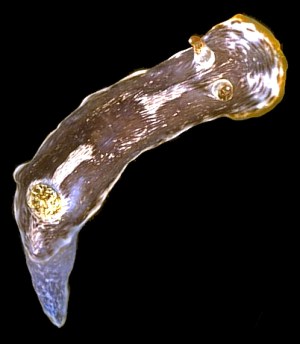
Dear David & Leanne,
This is a colour form of Chromodoris striatella. I have only found this form in New South Wales, (eastern Australia). If you look at the photos from Darwin, at the top of the page you will see there is a pattern of 5 darkish patches, 2 behind the rhinophores, 2 in front of the gills, and one in the middle. Although it is a bit hard to see the detail in Judi Martin's photo, in the photo I have added to the right, you can see that in this darker colour form these 5 patches have enlarged to dominate the colour pattern. However, if you look carefully, there are still traces of the characteristic black lines.
PHOTO: Solitary Islands, off Coff's Harbour, northern New South Wales, January 1989. PHOTO: Bill Rudman.
Best wishes,
Bill Rudman.
Chromodoris striatella? from Japan
June 19, 1999
From: Rie Nakano
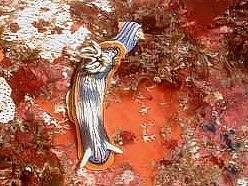
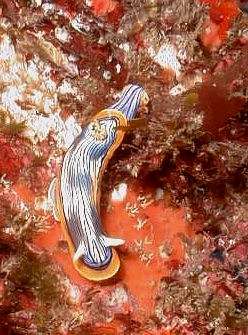
Dear Bill
How was International Opisthobranch Workshop at Sicily?
I dived in Hachijo Island last weekend.
Hachijo Island is about 300km away from Tokyo. This island is in the temperate zone, but is affected by warm current, underwater temperature is usually 18-26 degrees (24 degrees at this time).
On the land, many subtropical plants are in bloom all year around. But we can hardly see coral, because it is composed by volcanic rock.
We can see both temperate zone opisthobranchs and subtropical ones (like Kerama Islands) in Hachijo Is. This time I watched 25 species, over 60 individuals in 6 dives. I'm so happy.
Well,I have a question.
This opisthobranch is similar to Hypselodoris maritima (Baba,1949). But the color of rhinophore and gills of this one is white. H. maritima is orange, isnt it? I've never seen typical H. maritima in Hachijo Is, nor have local divers. Instead of H. maritima, I saw this species commonly. What name is this opisthobranch!?
If it is the color variation of H.maritima, why have we never seen typical H.maritima?
Length: 40mm, Depth:10m (15m at the sunken rock wall). Photo by Rie Nakano.
Sincerely,
Rie Nakano.
rie@street.ne.jp
Nakano, R., 1999 (Jun 19) Chromodoris striatella? from Japan. [Message in] Sea Slug Forum. Australian Museum, Sydney. Available from http://www.seaslugforum.net/find/949Dear Rie,
The workshop was very interesting and the organisers are planning to put the abstracts on their website soon. I will let you know when they do.
Concerning your nudibranch. I have prepared pages on Hypselodoris maritima, Chromodoris striatella and Chromodoris lineolata for comparison. I am pretty sure your animal is a pale form of Chromodoris striatella. It looks very like the animal Dr Baba illustrates in his Opisthobranchs of Sagami Bay (1949)(as C. lineolata).
Rudman, W.B., 1999 (Jun 19). Comment on Chromodoris striatella? from Japan by Rie Nakano. [Message in] Sea Slug Forum. Australian Museum, Sydney. Available from http://www.seaslugforum.net/find/949